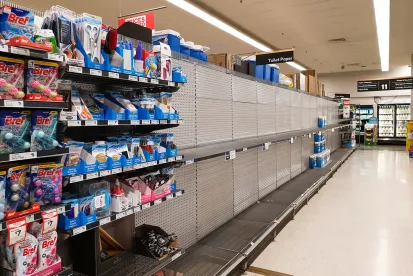In early March, California Attorney General Xavier Becerra issued a consumer alert on price gouging. Two weeks later, police in San Diego arrested eight people for price gouging. The same week, investigations by Sacramento authorities prompted new warnings from local authorities. Since then, both the Governor and Attorney General have indicated price gouging will remain top of mind. Typically, price gouging laws extend for short periods — weeks or a month — but we now know that California price gouging rules will remain in effect through September.
California has a price gouging statute designed to prevent sellers at all points in the supply chain from implementing certain price increases during a statewide or national emergency. Unlike most states however, California’s law includes a hard cap for price increases on covered products — 10%. California constitutes almost one-seventh of the nation’s economy and therefore has an outsized impact on the legal rules throughout the U.S. Significantly, California’s law sets one of the most stringent benchmarks in the nation, and because of the state’s importance in the national economy, this provides a useful benchmark for companies in their nationwide compliance efforts.
California Price Gouging Basics
Like most price gouging laws, California’s law, Cal. Penal Code title 10, § 396, moves into effect “[u]pon the proclamation of a state of emergency” declared by the President, Governor, county, or city. The law is intended “to protect citizens for excessive and unjustified increases in the prices charged during or shortly after a declared state of emergency.” California declared a state of emergency on March 4, 2020.
The law has two different periods – 30-day prohibitions and 180-day prohibitions. The primary 30-day prohibition, part (b), declares:
it is unlawful for a person, contractor, business, or other entity to sell or offer to sell any consumer food items or goods, goods or services used for emergency cleanup, emergency supplies, medical supplies, home heating oil, building materials, housing, transportation, freight, and storage services, or gasoline or other motor fuels for a price of more than 10 percent greater than the price charged by that person for those goods or services immediately prior to the proclamation or declaration of emergency.
The other 30-day rules cover hotel and motel rates (part (d)), rents (part (e)), and evictions (part (f)). The 180-day period, part (c), applies to contractors and those offering “reconstruction services.” Each of these prohibitions can be extended if “deemed necessary to protect the lives, property or welfare of the citizens.” Cal. Pen. Code tit. 10, § 396(g). On April 3, 2020, Governor Newsom extended the period for all goods subject to part (b) through September 4, 2020. Below is a table of relevant dates as of publication:
|
County |
Price Gouging in place until: |
|
Mendocino |
12/31/2020 (extended via Executive Order N-22-19) |
|
Napa |
12/31/2020 (extended via Executive Order N-22-19) |
|
Santa Barbara |
12/31/2020 (extended via Executive Order N-22-19) |
|
Sonoma |
12/31/2020 (extended via Executive Order N-22-19) |
|
Butte |
12/31/2020 (extended via Executive Order N-22-19) |
|
Los Angeles |
12/31/2020 (extended via Executive Order N-22-19) |
|
Ventura |
12/31/2020 (extended via Executive Order N-22-19) |
|
Riverside due to fires |
4/9/2020 (for emergency cleanup, repair, or reconstruction per Penal Code Section 396, subdivsion (c)) |
|
Statewide due to fire weather conditions |
4/25/2020 (for emergency cleanup, repair, or reconstruction per Penal Code Section 396, subdivsion (c)) |
|
Statewide due to the Coronavirus |
9/4/2020 (for all prohibitions in subdivision (b), per Proclamation of a State of Emergency dated 3/4/20, and extended via Executive Order N-44-20) |
How Does The Price Cap Work?
California’s 10% cap is one of the most stringent caps in the nation. But this benchmark begs the question: 10% of what baseline price? Part (b) of the law specifies the cap as: “10 percent greater than the total of the cost to the seller plus the markup customarily applied by the seller for that good or service in the usual course of business immediately prior to the onset of the state of emergency.” Cal. Pen. Code tit. 10, § 396(b). The law specifies businesses can use “the price at which [they] usually sell the item,” if they were “offering an item for sale at a reduced price immediately” before the emergency. Cal. Pen. Code tit. 10, § 396(l).
Governor Newsom’s April 3rd Executive Order, N-44-20, modified this baseline rule slightly. For a subset of products, the Governor provided a specific look-back to February 4, 2020. As a result, the relevant date for assessing the 10% increase will be earlier for some goods than others. This rule applies to food items, consumer goods, medical or emergency supplies, and materials designated as scarce or threatened materials under the Defense Production Act. The first three groups are defined terms in the statute. For the fourth, the Department of Health and Human Services issued listing, among other things, N95 face masks, surgical gowns, ventilators, and other medical supplies.
The Governor also imposed an additional restriction for the goods listed in his order: restrictions on new sellers. Governor Newsom ordered that sellers who did not offer a product for sale on February 4, 2020, may not sell or offer to sell that product for more than 50% of the amount that person paid for the item, or the total cost of producing and selling the item, whichever is greater. This means that some new sellers of goods will likely be able to offer goods at higher prices than those charged by current sellers.
Like most states, California also includes an exception for increased costs. Price increases over 10% are not unlawful if the seller can prove the increase was:
directly attributable to additional costs imposed on it by the supplier of the goods, directly attributable to additional costs for labor or materials used to provide the services, during the state of emergency or local emergency, and the price is no more than 10 percent greater than the total of the cost to the seller plus the markup customarily applied by the seller for that good or service in the usual course of business immediately prior to the onset of the state of emergency or local emergency.
Cal. Pen. Code tit. 10, § 396(b). This standard gives some leeway for sellers to establish what their usual price is. This may be easy for some sellers with set markups. However, sellers with more nuanced pricing may have to calculate averages or other baselines like those used in other states’ price gouging rules.
This exception does not specifically exclude price increases tied to an index. Consider an individual seller that prices its product using a common index. If the index price suddenly jumps, but the seller’s costs do not, the price gouging exception may not apply. Sellers using automatic index-based-pricing mechanisms may unwittingly stumble into a price gouging violation without consciously taking steps to increase prices. As a result, companies should consider monitoring the prices in any contract that sues an index-based-price mechanism, and measuring any price changes against California’s (and other states’) price gouging statutes.
Also, the Governor’s Order specified that it is not a violation to sell products to the state at terms the state deems acceptable.
Penalties & Enforcement
California’s statute includes civil and criminal penalties for price gouging. The Attorney General will likely reserve criminal penalties for the most egregious cases, but price gouging is technically a misdemeanor, and it comes with a fine of up to $10,000 and no more than one year in jail. Cal. Pen. Code tit. 10, § 396(h). It also comes with civil penalties. Violations of California’s price gouging law are also considered “an unlawful business practice and an act of unfair competition” under California Bus. & Prof. Code § 17200, et seq. Cal. Pen. Code tit. 10, § 396(i). California’s unfair competition laws state victims of price gouging can seek injunctions. The Attorney General, district attorneys, county counsel, or cities can also seek their own injunctions, restitution, and civil penalties of up to $5,000 per violation.
The penalties can add up quickly. Governor Newsom specified that each sale is a separate offense. Similarly, each instance in which an item is offered for sale, is also a separate offense. This interpretation applies to both the criminal and civil penalties, each of which is already cumulative.
See also our summary of enforcement in NY for relevant updates with respect to that state’s efforts combat price gouging.






 />i
/>i

